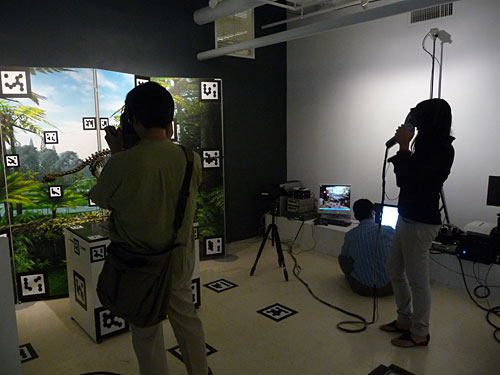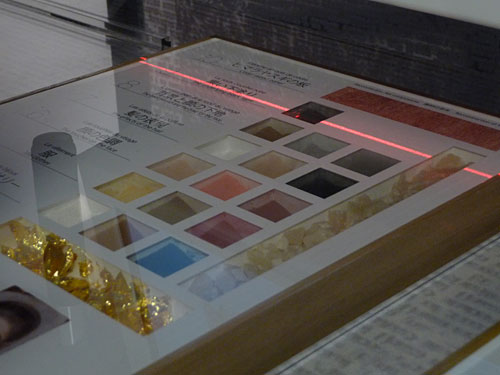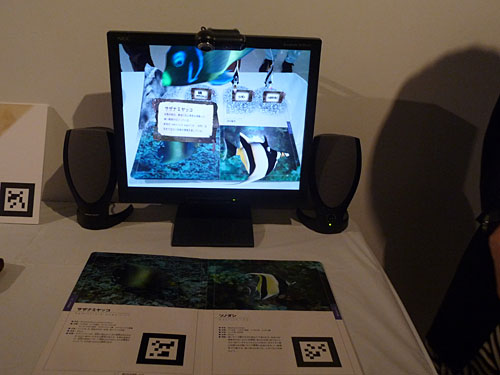This story starts with a dinosaur.
It’s a bipedal one, sort of like a mini Tyrannosaurus, running around by my feet. My friend laughs as he sees it scurry beneath me. It’s somewhat different from what I’d imagined, though. I press a button, and it changes skin tone. I try to touch it, and my hand passes straight through. But as I crouch down, it looks me straight in the eye. Then it waves and vanishes into a wall. It’s gone.
The dinosaur before me is a stunning example of mixed reality, the subject of a recent show at Onishi Gallery in Chelsea sponsored by Canon and KBK Ltd. Mixed reality places virtual world objects onto the real world, allowing anything from dinosaurs to interior design concepts come to life. Unlike screen-based augmented reality and 3D projections, these headsets create a fundamentally different experience by capturing your entire periphery. The two worlds of computers and physical objects truly mesh.

Both wearing headsets, a visitor and I are able to share in the same experience of the dinosaur.
“People would be surprised when they entered the gallery,” said gallery director Nana Onishi over sips of green tea. “‘It’s not art,’ they would tell me. ‘It’s technology.'” Her eponymous gallery focuses on traditional Japanese art in contemporary contexts, such as metal leaf work and scrolls inspired by the Tale of Genji. This was her first technology show.
“I was like them,” she said of her first encounter with Canon’s headsets. Shortly thereafter, however, she decided to host them at her gallery, where they showed the technology to the general public for the first time. “Since I’ve come to know the project, I have had so many ideas and images for projects.”
From Dinosaurs to Mummies
Immediately after the mixed reality show, Onishi Gallery hosted the Louvre-DNP Museum Lab, a collaboration between the museum and the Dai Nippon Printing Co. to develop multimedia tools that bring to life traditional art objects. This time, the show had a more specific purpose: to demonstrate how new technologies can benefit cultural instutions and enhance arts education.
Ms. Onishi and the Museum Lab representatives invited me to sit down in front of a screen depicting a traditional mummy portrait from Roman Egypt, in the Louvre’s collections. I’d seen it before in books: one of the famous Fayum portraits, this woman lived during the second century, but she stares back with stunning clarity.
What I’d not seen before, however, was how many layers made up each portrait. The screen itself hovers over a box containing different painting materials, from hardwood to wax to gold leaf. It casts a thin red line as if reading a bar code. As I bring the screen closer to me, the red line hovers over the materials and visually adds the corresponding layer on the portrait. It’s as if I am watching the original artisan develop the picture, piece by piece, material by material.
Video by Dylan Schenker
I walk over to an unassuming plate. A few inches round, it represents a 9th century ceramic platter from the Louvre’s collections, unearthed and reassembled from fragments from a site in present-day Iran. As I hold up a screen, the plate, like the dinosaur, comes alive. Its original cracks are highlighted, and I watch as the different fragments come apart, showing me how the plate was originally discovered. Labels pop up to explain the plate’s history and the conservation work.
“This is very useful,” Ms. Onishi explained. “With this device, you can actually see a map of the place where the artwork was found. You can see how it was pieced together.”
Video by Dylan Schenker
The gallery features a host of other devices, from a book of aquatic life that animates different fish onto a television screen as you flip through it, to a touch-screen projection that explains the history of the Fayum portraits and mummification practices. Some, like the projection, feel a little clumsy in our age of instant-on iPhones. Others strike me as “gee-whiz” examples of technology without a clearly-defined purpose. But in all of these works, I can see the potential for making both traditional art objects and contemporary art more interactive for an audience increasingly accustomed to, and expectant of, digital interaction.
“Much of contemporary art is about working with the viewer, being more interactive,” said Ms. Onishi. “These devices are perfect for a museum. People play with them, both physically and mentally.”

Detail of the “scanning” system used with the Fayum mummy portraits
Potential and Promise
As social media evolve, we’re beginning to see a greater and greater interaction with the digital and physical worlds. Twitter and Facebook are beginning to integrate location-aware services in the vein of Foursquare, and products like Nike+ make the physical act of exercise an equally digital experience, with rich charts and graphs illuminating the user’s activity. Works situated solely in the computer may one day feel as quaint (or classic, depending on your perspective) as daguerreotypes do today.

A new kind of “pop up” book: as you flip the pages to read more about the fish, an animation pops up in front of you.
Technologies like Canon’s headsets and Louvre-DNP’s handheld tablets have the potential to further blur the borders by augmenting art objects with rich expanses of digital information. Whether they ultimately enhance the art experience or distract from the original objects remains to be seen. What’s clear, however, is these technologies allow viewers to engage simultaneously in both the digital and physical worlds.
The most thrilling example of this is Canon’s mixed reality headsets, which alter your entire visual world with everything from a scurrying dinosaur at your feet to a dancing angel above you. It can be used to simulate design prototypes in the palm of your hand and to illustrate the technicalities of a global positioning system. Though virtual, the objects are truly three dimensional, allowing anyone wearing a headset to see them from any conceivable angle.
I ask Ms. Onishi about the future, and she hinted at potential shows during the DUMBO Art Under the Bridge Festival and along the High Line. “The people at Canon are very much interested in working with New York City,” she explained.
She motioned toward 11th Ave., where the High Line runs. “Imagine making a train run virtually along the High Line, like it used to. But since it’s virtual, the train can go into the sky. It can fly around, above people’s heads. And then it can come back.”
Onishi Gallery is located at 521 W 26th St. in New York.




Pingback: Former Edwards aide: ‘I was scared for my life’ (CNN) | National Geographic Volcano Eruptions
Pingback: Body Painting Models Bodies Blog